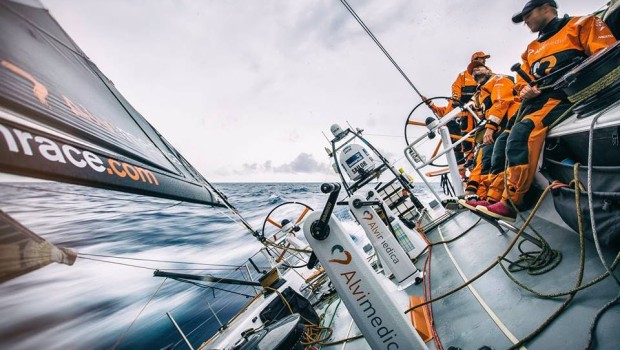Team Alvimedica: Climbing the learning curve
Published on March 8th, 2015
To succeed in the Volvo Ocean Race, it is critical to constantly improve. While lead teams Abu Dhabi and Dongfeng are approaching the plateau of their learning curve, Team Alvimedica still has some climbing to do.
“Improving our boat speed is our focus,” notes Alvimedica skipper Charlie Enright. “It’s no secret that Abu Dhabi and Dongfeng are a little bit quicker than the rest and as a result, their lives are navigationally and tactically a bit easier.”
One of the boats speed variables for the Volvo Ocean 65 has been the outrigger, a strut that extends the front sail sheeting angle outboard. It has also been a source of equipment failure.
“Teams carry two outriggers, but are allowed to carry a spare, which we do, so we have three onboard,” explains Enright. “There are two attachment points – one by the shrouds for the headsails and one by the steering wheels for the bigger code sails. But there is a lot of set-up options in terms of their angle, deciding how to position them up and down and fore and aft to effectively trim the sail. There are also various ways to accomplish the positioning of the strut, and maybe not every way is structurally sound. There have been some breakages.”
Breakages tend to be a result of taking risks, a question that Enright battles with.
“This past leg was primarily the forward outrigger for the J1 and we feel like we have a pretty good setup. I’d say that we probably have a B+ setup. I think some of the guys probably have an A+ setup, but every now and then they get an F when they break it and it slams back through the coach roof or bust the J1 halyard lock. Maybe the B+ is the way to go and failing every now and then is going to become unsustainable, but until now nobody’s really been punished for it.
“But if this leg had some A3 running left, and MAPRE was out of outriggers, they may not have been able to win in Auckland,” ponders Enright. “If you asked me today I’d say we’re probably not pushing hard enough with the loads, but once someone cops it for breaking all their outriggers or their fittings or their strops or whatever, maybe the B+ is about right.”
“We didn’t have any breakages on Leg 4, which is either a testament to our boat captain Nick Dana and shore team or that we are just not pushing hard enough. I’d like to think we are pushing pretty hard, but if other teams are benefiting from pushing harder, we will need to wait and see if their breakages prove to be worse than the benefit.”
While the team keeps improving, Enright sees himself evolving too.
“I am gaining perspective,” Enright assesses. “Everything was new when we started this, and now we’ve got a little bit more experience under our belts. In the beginning, and I guess to some extent still, you’d hang on to every sked, you’d hang on to every forecast, every grib, and now I think I’ve learned to step back and take them a little bit more for what they are. They’re not the gospel. They’re not the end-all, be-all. They’re just basically status reports amid a much bigger picture.
“Amid all this information, you’re still just looking at boats on a course, and figuring out the risk and the percentages of each decision,” notes Enright. “I think the last couple legs, we’ve done a pretty good job positioning the boat on the racecourse, and if we can continue to do that and improve our speed here and there, who knows what could happen.”
One of the things Enright would like to see happen is to disrupt the pecking order, as teams like Abu Dhabi, Dongfeng, and Brunel tend to jump out at the start of each leg.
“We’ve been generally in the same water as the leaders, and in particular in this last leg, but they’re just a little bit quicker,” admits Enright. “We feel like we’re making improvements, certainly. And looking to make more on this leg and obviously as we go along. When there are more routing choices and the fleet spreads out a little bit more, it could be a bit of a different story. But as long as the boats stay together, the fleet will finish in the order that they go through the water. However, we know where our trouble areas are and we’re continuing to work on them.”
Enright would like nothing more than to have it all worked out for Leg 6, when the course finished in his homeport of Newport, RI. He is also eager to see the New England stopover compete with the other ports.
“Auckland has really turned out. They set the bar, so we got a lot to live up to in Newport. But we can do it.”
Game on!
Background: The 2014-15 Volvo Ocean Race began in Alicante, Spain on Oct. 11 with the final finish on June 27 in Gothenburg, Sweden. Racing the new one design Volvo Ocean 65, seven teams will be scoring points in 9 offshore legs to determine the overall Volvo Ocean Race winner. Additionally, the teams will compete in 10 In-Port races at each stopover for a separate competition – the Volvo Ocean Race In-Port Series. The fifth leg, from Auckland, NZL to Itajaí, Brazil (6,776 nm), begins March 15 with an ETA between March 31 and April 10. Race website: http://www.volvooceanrace.com/en/home.html









 We’ll keep your information safe.
We’ll keep your information safe.